In Charts: Covid-19 and the Welsh labour market
16 November 2020Following the release of new labour market data last week, Jesús Rodríguez and Cian Siôn from the Wales Fiscal Analysis (WFA) team walk us through what this tells us about the pandemic’s impact on the Welsh workforce and job market.
As Wales emerges from its 17-day ‘fire-break’ lockdown, the country remains gripped by the pandemic. New national measures allow premises that were temporarily closed – and remain closed in England – to reopen subject to a new set of rules. But latest data tracking people’s mobility show visits to retail and recreational spaces (such as restaurants, bars and cafes) remain below usual levels, suggesting demand for these businesses is and will remain depressed.
ONS data released on Tuesday paints a picture of a similarly depressed labour market, with rising unemployment and subdued levels of vacancies.
Even so, the mass redundancies that were widely expected if the furlough scheme was gradually wound down do not appear to have materialised. The UK Chancellor’s welcome (although belated) decision to extend the scheme until March 2021 means that the labour market remains – in effect – partly ‘frozen’.
What do the headline economic indicators tell us?
The headline economic indicators have begun to reflect the economic consequences of Covid-19. Data for July to September 2020 show an estimated 67,000 people were unemployed, this figure represents 9,000 (+15.3%) more than a year earlier and 27,000 (+65.2%) more than the previous quarter.
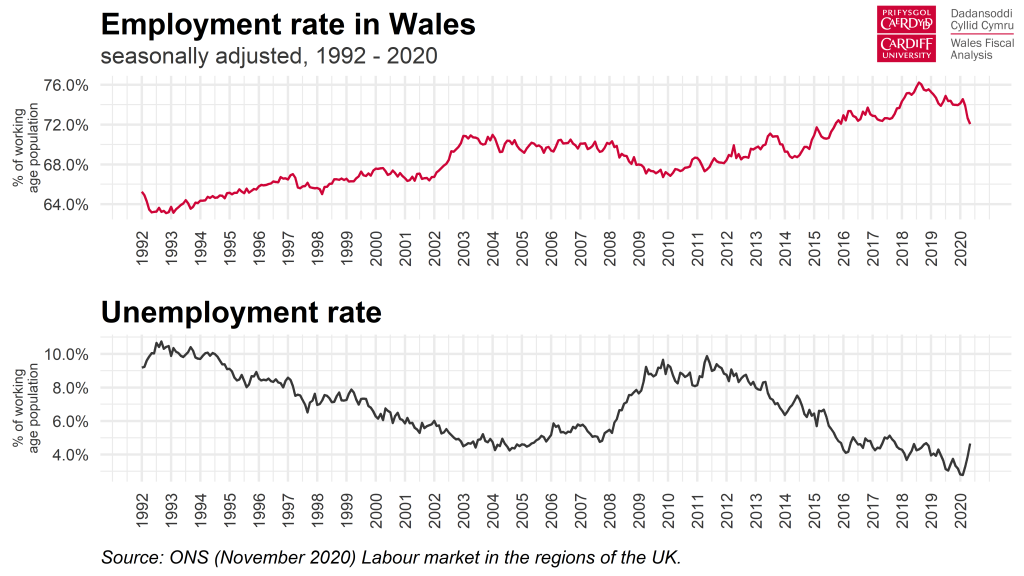
The estimated unemployment rate in Wales rose to 4.7% in the three months to September; this is 0.7 percentage points higher than a year earlier and 1.9 percentage points higher than the previous quarter – though lower than the UK average of 4.8%.
Wales had not experienced such a large quarter-on-quarter increase in the unemployment rate since the 2008 financial crisis.
This increase is largely explained by lower employment, with the employment rate amongst 16–64 year olds declining to 72.1% in the September estimates. The three-month employment rate is now down 2.5 percentage points on the previous quarter.
Having recorded a lower economic inactivity rate than the UK for the first time since records began in 2018, the Welsh economic inactivity rate now appears to be rising and the gap between it and the rest of the UK widening – though this trend pre-dates the onset of the pandemic.
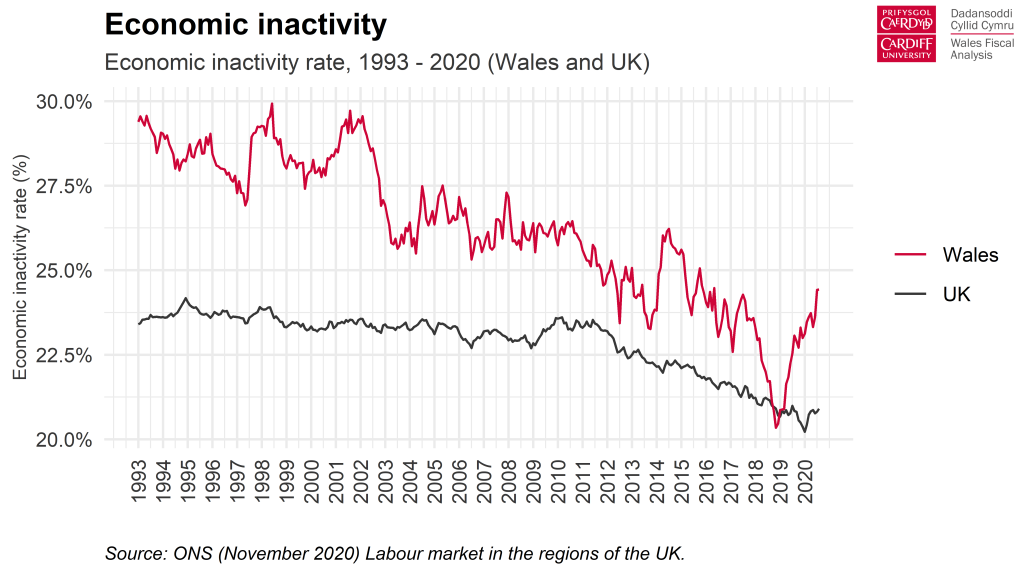
An estimated 25,000 additional adults aged 16–64 were not in employment and not actively seeking work in Wales between July and September 2020 compared to the period spanning December 2019 – February 2020.
This increase appears to be proportionately greater than the UK average, but since the Welsh series is sensitive to statistical noise, it is too early to tell for sure.
Who’s hiring – and who’s not?
Across the UK, redundancies increased by a record 181,000 on the quarter to reach a new high of 314,000. This figure is higher than at the peak of the 2008–09 financial crisis in absolute terms, but it’s not really a record high.
As a share of the workforce, today’s redundancy rate is still slightly off the dark days of the 2008 downturn – and not remotely close to the experiences of the 1980s.
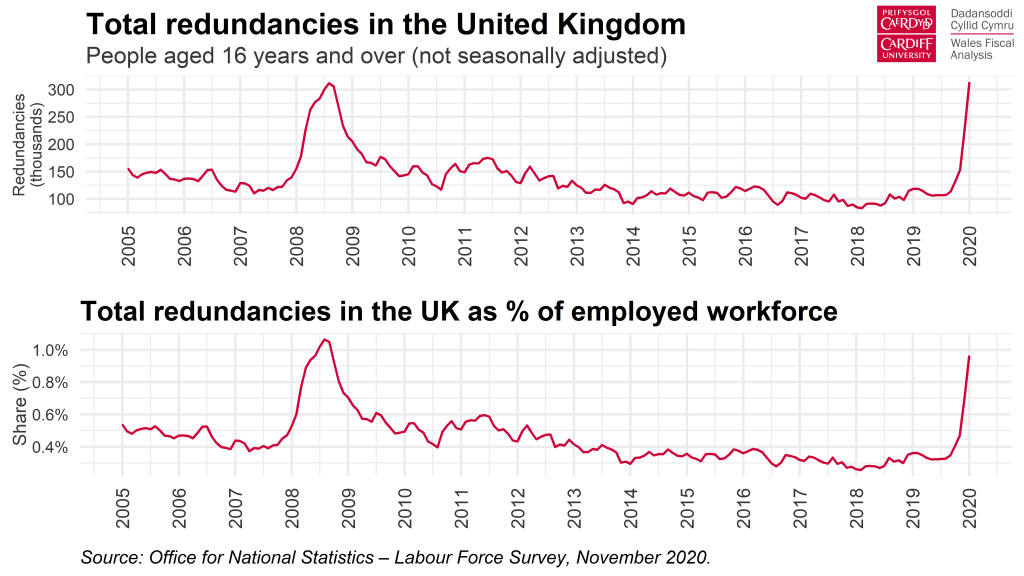
The number of vacancies is a key element to observe during the current economic crisis as it gives us an idea of the rates at which people can find a job.
In this regard, the data for both Wales and the UK show a positive trend and vacancies continue to recover. However, in Wales they had still only recovered to half of their pre-covid levels in the most recent month of data.
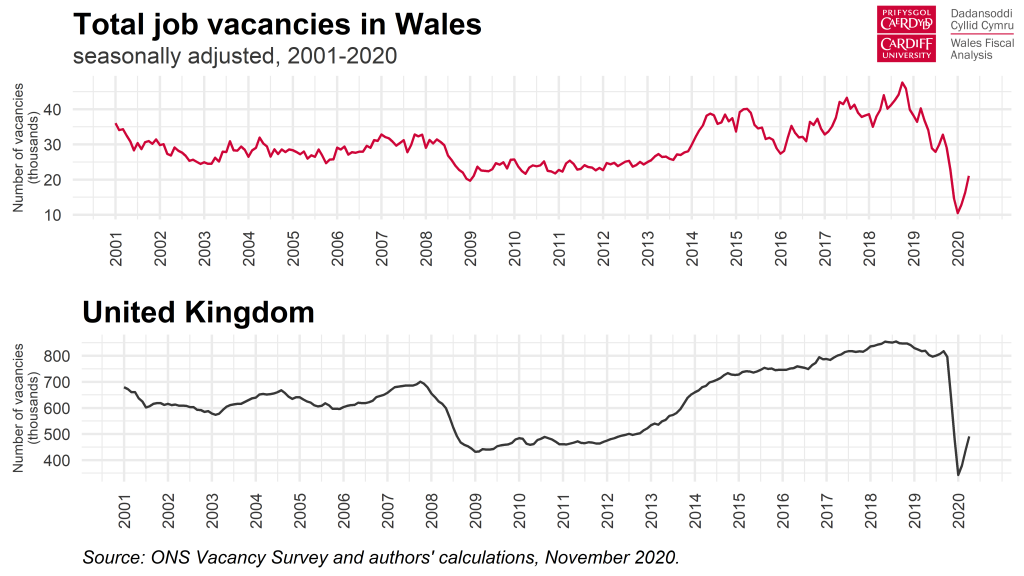
The number of job adverts over time is an indicator of the demand for labour. In the latest week, the volume of job adverts decreased in all UK countries.
Although Wales has the highest index of job adverts (76.7%) in the UK, this figure is still 33% lower than what had been registered prior to the pandemic.
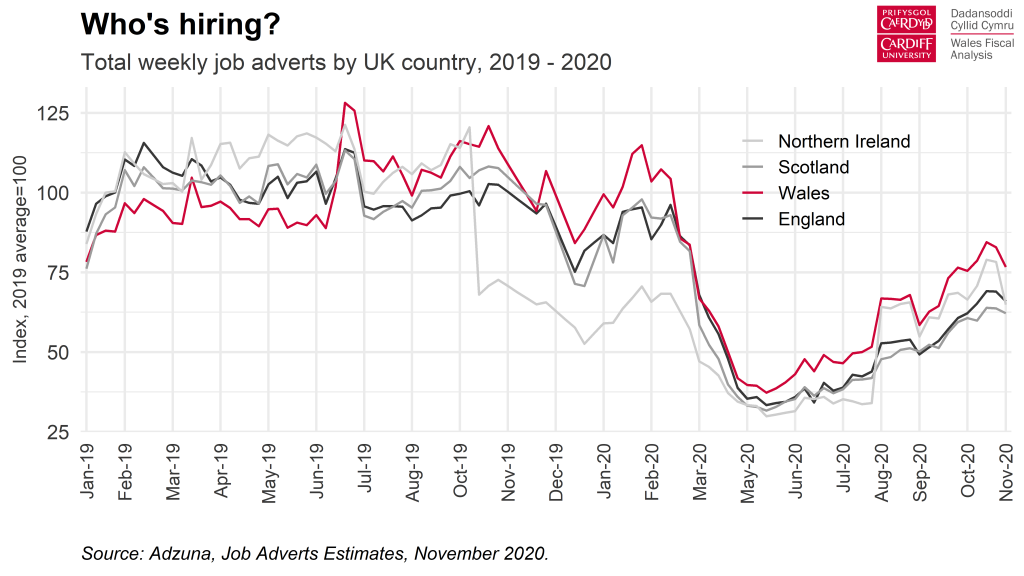
How many Welsh workers remain on furlough?
Since March 2020, over 400,000 employments have been furloughed in Wales. The latest official data from HMRC showed 130,400 employments still furloughed by the end of August.
Our own estimate based on more timely data from the Business Impact of Coronavirus Survey (BICS) suggests that this number had fallen to around 80,000 by mid-October, equivalent to 8% of the Welsh workforce (down from 26% in May).
And in a recent tweet, the Chancellor Rishi Sunak implied that this figure had fallen further to 68,000 by the start of November.
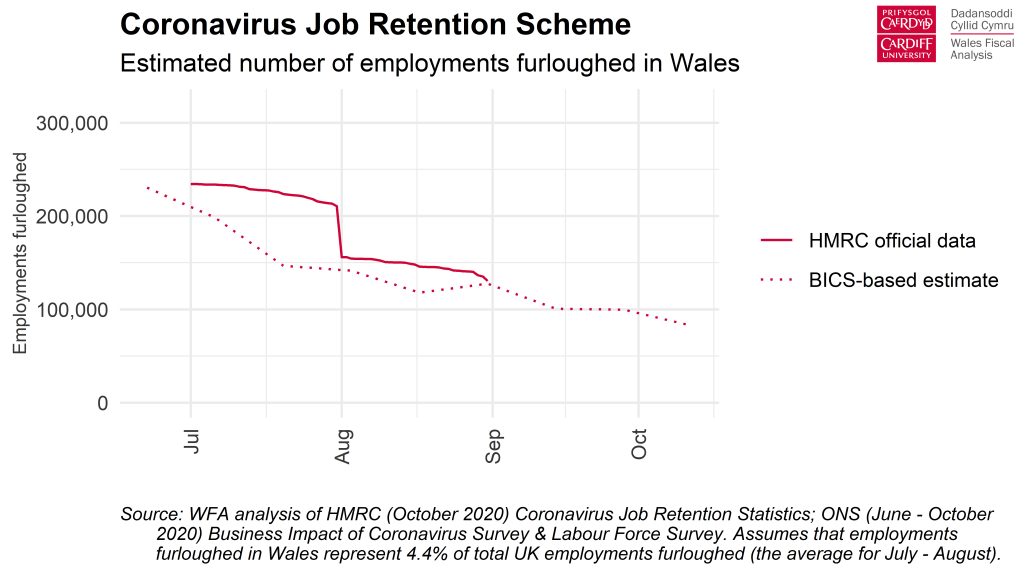
The reduction in the number of workers furloughed has not been accompanied by a similarly sized increase in unemployment, suggesting that the vast majority of furloughed workers have in fact been brought back onto the payroll.
This hypothesis is supported by HMRC data on earnings and employment from Pay as you Earn (PAYE) real time information.
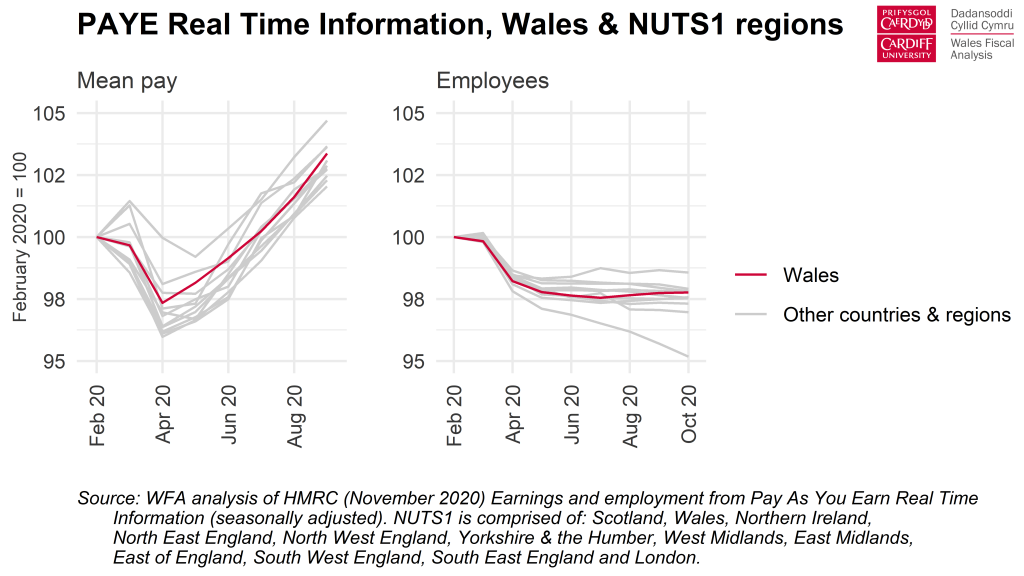
The average PAYE award in Wales fell by around 2% between February and April 2020, but has since recovered and surpassed its pre-Covid level. This likely reflects the flow of employees onto the furlough scheme, when they were liable to pay Income Tax on 80% of their wages, and then back into full employment or unemployment.
After an initial reduction in April, the number of Welsh employees on the PAYE register has remained broadly stable at 2% below its pre-Covid level, suggesting that most employees have in fact been kept on.
A broadly similar pattern can be seen in Scotland, Wales, Northern Ireland and each of the nine regions of England.
A sharp increase in redundancies and subdued levels of vacancies paint a worrying picture for those hoping for a swift labour market recovery.
Although the furlough scheme has been successful in shielding the labour market from the most adverse effects, it remains to be seen how many of the estimated 80,000 Welsh workers still partly or fully furloughed will return to full employment once the scheme ends.
Despite the support packages put in place, many have still fallen through the cracks.
The number of households on Universal Credit has risen sharply since March. And if the UK government presses ahead with plans to reverse the temporary increase to the standard allowance, 35% of Welsh households are set to lose £1,000 a year from April 2021.
An increase in economic inactivity suggests that others have dropped out of the workforce altogether. We know that prolonged periods of unemployment can have a lasting impact on future earnings and career prospects, particularly for young people and those from disadvantaged backgrounds. Failing to offer adequate support to these groups risks further entrenching existing inequalities.
Lastly, most of the indicators presented here pre-date the new national lockdown measures introduced in recent weeks, as well as the Chancellor’s decision to extend the furlough scheme.
It is possible that employers may have been cutting jobs in October in anticipation of a November end to the Job Retention Scheme?
If so, furlough may have saved jobs, but belated decisions may have cost some too.
The data and replication files for the charts can be accessed here.
- December 2025
- November 2025
- October 2025
- September 2025
- June 2025
- May 2025
- March 2025
- February 2025
- December 2024
- October 2024
- September 2024
- July 2024
- June 2024
- December 2023
- November 2023
- August 2023
- February 2023
- December 2022
- November 2022
- September 2022
- July 2022
- April 2022
- March 2022
- January 2022
- October 2021
- July 2021
- May 2021
- March 2021
- January 2021
- November 2020
- October 2020
- August 2020
- July 2020
- June 2020
- May 2020
- April 2020
- March 2020
- October 2019
- September 2019
- June 2019
- April 2019
- March 2019
- February 2019
- December 2018
- October 2018
- July 2018
- June 2018
- April 2018
- December 2017
- October 2017
- July 2017
- June 2017
- May 2017
- April 2017
- March 2017
- February 2017
- January 2017
- December 2016
- November 2016
- October 2016
- September 2016
- Bevan and Wales
- Big Data
- Brexit
- British Politics
- Constitution
- Covid-19
- Devolution
- Elections
- EU
- Finance
- Gender
- History
- Housing
- Introduction
- Justice
- Labour Party
- Law
- Local Government
- Media
- National Assembly
- Plaid Cymru
- Prisons
- Reform UK
- Rugby
- Senedd
- Theory
- Uncategorized
- Welsh Conservatives
- Welsh Election 2016
- Welsh Elections